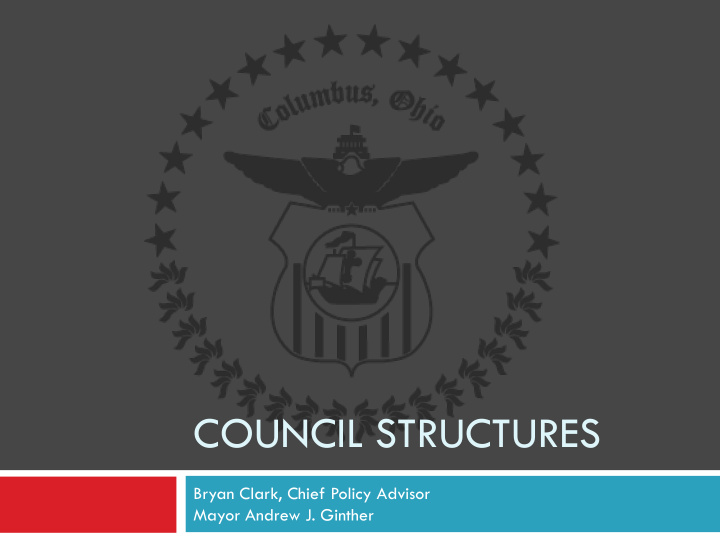



COUNCIL STRUCTURES Bryan Clark, Chief Policy Advisor Mayor Andrew J. Ginther
COLUMBUS CITY COUNCIL Columbus City Charter Sec. 3. - Legislative powers “The legislative powers of the city, except as reserved to the people by this charter, shall be vested in a council, consisting of seven members, elected at large .”
COUNCIL STRUCTURES OVERVIEW OF COUNCIL STRUCTURES IN AMERICA’S TOP 50 CITIES
AT-LARGE COUNCIL Councilmembers are elected by the entire city, which serves as a “multi -member district.” Members are elected either in a field race or by-place At-large field and at-large by-place elections are among the most competitive and contested in the country
WARD COUNCIL Councilmembers are elected from geographic wards or districts. Members are elected by-place (aka, head-to- head) Elections are among the least competitive in the country
HYBRID COUNCIL Great deal of variation, but three most common forms Multiple members elected at-large field and the remainder elected from wards One or more members elected at-large by-place and the remainder elected from wards Members elected at-large by-place, but qualify for the ballot based on districts
HYBRID/AT-LARGE FIELD Council consists of some members elected by the entire city and some elected from wards At-large members run against each other in a field race, may live anywhere in the city and are voted on by every eligible elector Ward members file for a specific seat on council based on where they live and are only voted on by the electors of that ward
HYBRID/AT-LARGE FIELD BALLOT
HYBRID/AT-LARGE BY-PLACE Council consists of some members elected by the entire city and some elected from wards At-large members file for a specific seat on council and run against other candidates for that seat, but may live anywhere in the city and are voted on by every eligible elector Ward members file for a specific seat on council based on where they live and are only voted on by the electors of that ward
HYBRID/AT-LARGE BY-PLACE BALLOT
HYBRID/DISTRICT Council consists of members who qualify for election by district, but are elected by the entire city in the primary and the general Members file for a specific district based on where they live and run against other candidates who live in that district Members are voted on by every eligible elector
HYBRID/DISTRICT (cont.) Variations of the Hybrid/District system are used in the following places: Tuscon, AZ Reno, NV Sparks, NV Washington State county commissions (32 of 39), as well as some cities and school districts
HYBRID/DISTRICT BALLOT
COMPETITIVE ELECTIONS OVERVIEW OF THE COMPETITIVENESS OF ELECTIONS IN AMERICA’S TOP 25 CITIES
METHODOLOGY Based on original data for the elections covering all members of council in the nation’s largest 25 cities For Contestedness , divide the number of seats up for election by the number of seats with more than one candidate For Margin , subtract the lowest winning vote percentage from the highest losing vote percentage* For Incumbents , divide the number of incumbents who lost by the number of incumbents running**
MOST CONTESTED ELECTIONS MARGIN INCUMBENTS CONTESTED LOSE AT-LARGE (FIELD) 97.14% 7.26% 9.80% AT-LARGE (BY-PLACE) 90.00% 32.05% 11.24% WARD 87.58% 35.07% 5.17% WARD (BY-PLACE) 79.38% 33.66% 4.62% WARD (FIELD) 66.76% 53.75% 8.61%
LOWEST MARGIN OF VICTORY MARGIN INCUMBENTS CONTESTED LOSE AT-LARGE (FIELD) 97.14% 7.26% 9.80% AT-LARGE (BY-PLACE) 90.00% 32.05% 11.24% WARD (BY-PLACE) 79.38% 33.66% 4.62% WARD 87.58% 35.07% 5.17% WARD (FIELD) 66.76% 53.75% 8.61%
INCUMBENTS LOSE ELECTION MARGIN INCUMBENTS CONTESTED LOSE AT-LARGE (BY-PLACE) 90.00% 32.05% 11.24% AT-LARGE (FIELD) 97.14% 7.26% 9.80% WARD (FIELD) 66.76% 53.75% 8.61% WARD 87.58% 35.07% 5.17% WARD (BY-PLACE) 79.38% 33.66% 4.62%
100.00% 90.00% 80.00% 70.00% 60.00% 50.00% 40.00% 30.00% 20.00% 10.00% 0.00% CONTESTED MARGIN INCUMBENTS, LOSE AT-LARGE (BY-PLACE) 90.00% 32.05% 11.24% WARD (BY-PLACE) 79.38% 33.66% 4.62% AT-LARGE (FIELD) 97.14% 7.26% 9.80% WARD (FIELD) 66.76% 53.75% 8.61% WARD 87.58% 35.067% 5.17% COMPETITIVENESS OF ELECTIONS
HYBRID/DISTRICT HOW A HYBRID/DISTRICT SYSTEM MIGHT WORK IN THE CITY OF COLUMBUS
CURRENT BEST PRACTICES Based on data and analysis throughout this process, Columbus employs the following best practices for its City Council elections: Nonpartisan elections Staggered terms Elimination primary and general election Every voter has a voice for every elected official in the city.
HYBRID/DISTRICTS: A Columbus Plan What might Hybrid/Districts look like in Columbus? Expand Council to 9 members; Establish 9 districts using proven best practices; Require members to qualify for nonpartisan elections based on the district in which they live; Require candidates to run against other candidates from that district in a primary and a general; Serve staggered terms; and Allow every eligible Columbus elector to vote for every member of council.
HYBRID/DISTRICTS: A Columbus Plan What are the potential benefits of this system? Establish geographic representation and accountability without creating parochial interests Allow councilmembers to maintain a city-wide vision with a neighborhood focus Maintain voters’ rights to choose their elected officials Utilize the most politically competitive council structures Bring council’s size into the norm for peer cities
HISTORIC TRANSITIONS Columbus City Charter Sec. 4. - Council members “All council members shall serve for a term of four years; except that at the first election the four candidates having the highest number of votes shall serve for four years, and the three candidates having the next highest number of votes shall serve for two years.”
Recommend
More recommend